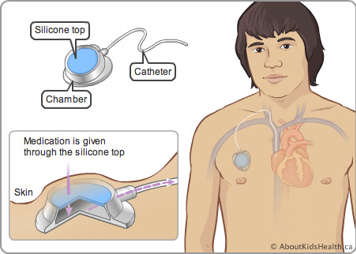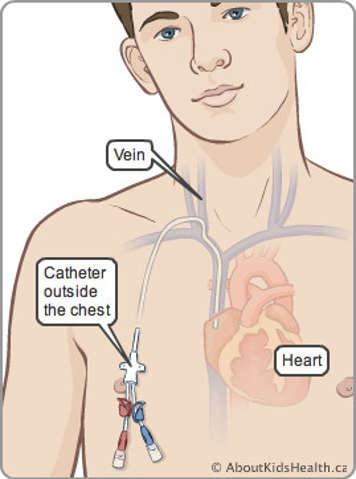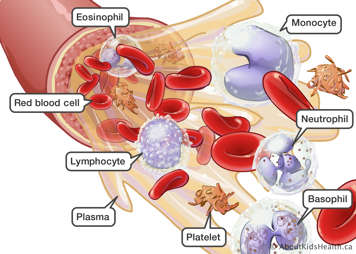What are blood tests?
Blood tests are also called "blood work."
Two common types of blood tests are used to help diagnose and monitor cancer:
- Complete blood count (CBC)
- Blood chemistry studies (which may include electrolytes, kidney function tests, and liver function tests)
How are blood tests done?
The first step in a blood test is to take a sample of your blood. The person trained to take blood is called a phlebotomist (say: fluh-BOT-um-ist). Sometimes a nurse may also take blood. The blood will be collected into small tubes called vials (say: vye-uls).
When you first have blood tests to see if you have cancer, they are usually done in a clinic or hospital. Your parent can stay with you during this test.
A blood sample can be taken in a number of ways.
With a needle
When the nurse or phlebotomist takes blood with a needle, they will first roll up your sleeve. Then they will tie an elastic band around your arm, above the area where the blood will be taken from. They will rub alcohol on your skin to clean the area where the needle will be inserted.
It will not take very long to take the blood. When the phlebotomist or nurse is finished taking blood, they will remove the needle. They will put a cotton swab and pressure on the spot where the needle had entered your skin to stop the bleeding.
Then they will put on a sticky bandage to keep the insertion site covered, although this is not always necessary.
With a finger poke
The nurse or phlebotomist will poke the pad (tip) of your finger with a pointy tool called a lancet. They will squeeze your finger to encourage bleeding. They will collect the blood in a vial.
From a port-a-cath

If you’re having chemotherapy or multiple blood tests, you may have a port-a-cath (or "port"). A port-a-cath is a small disk attached to a long thin tube. The port-a-cath is placed under the skin on your chest in a surgery; the end of the tube is placed in a big vein in your chest. It can stay in your chest for months or years. The nurse or phlebotomist can draw blood from you by pushing a special needle into the disk part of the port-a-cath. Some people use numbing cream over the port site before the test so they do not feel the needle being inserted. When the port is accessed with a needle, such as during chemotherapy, blood can be drawn directly from the port so there is no additional needle required.

From a central line
A central line is also a long thin tube. It is different from a port-a-cath because one end lies in a vein in your chest and the other end sticks out through your skin. It may stick out through the skin on your chest, at your neck, your upper arm or your upper thigh. The end of the tube that sticks out is covered by a cap with a special attachment. The nurse or phlebotomist can take the blood by connecting a syringe to this attachment. Taking blood this way doesn’t hurt.
How to cope with needle pain
Most people do not enjoy getting blood tests with a needle or finger poke, and a few people find it very difficult and stressful. There are some distraction techniques you can use to take your mind off the needle. See the communication section to find out some ways to help with needle pain. You can also talk to your doctor or nurse about your worries. They can suggest ways to reduce the discomfort from blood tests and ease any worries you might have.
Types of blood tests
Complete blood count (CBC)
This is a blood test used to check all the different types of cells in your blood. These include red blood cells, white blood cells and platelets. The test counts how many blood cells you have and checks what the cells look like.

A CBC gives the doctor an idea of your general health and whether they need to adjust your medications. Here are some of the more common things your doctor will be looking for in your CBC and what they mean:
| Type of blood cell | What the blood cell does | Abnormal test result findings | What the test results mean |
|---|---|---|---|
| Red blood cells | Carries oxygen from the lungs to the cells in the body. Hemoglobin is the part of the red blood cell that carries oxygen. | Low hemoglobin level | When your hemoglobin level is very low you may not have enough hemoglobin to carry oxygen around your body. You may feel tired, weak and dizzy or find that you become breathless easily. This is called anemia. |
| White blood cells | Part of the immune system, it keeps us healthy by fighting diseases and infections. | Too many white blood cells or white blood cells that look abnormal under the microscope Too few white blood cells | May be a sign of infection. In some cases, may be a sign of cancer in your blood and bone marrow such as leukemia. Your body may have trouble fighting infections. This is called neutropenia or leukopenia. |
| Platelets | Stops the body from bleeding when we are cut by forming a clot or scab. | Too few platelets | You may bruise more easily and be at risk of bleeding if you get an injury. |
Blood chemistry studies
Blood chemistry studies measure the levels of different chemicals in your blood called electrolytes or enzymes. These chemicals give information about how your organs, such as your kidneys or liver, are working. This is important to see how the cancer and treatment are affecting your body.
Tumour marker tests
Tumour markers are chemicals that some tumours make and release into your blood. A tumour marker test can help diagnose a cancer or see how it is responding to treatment.






